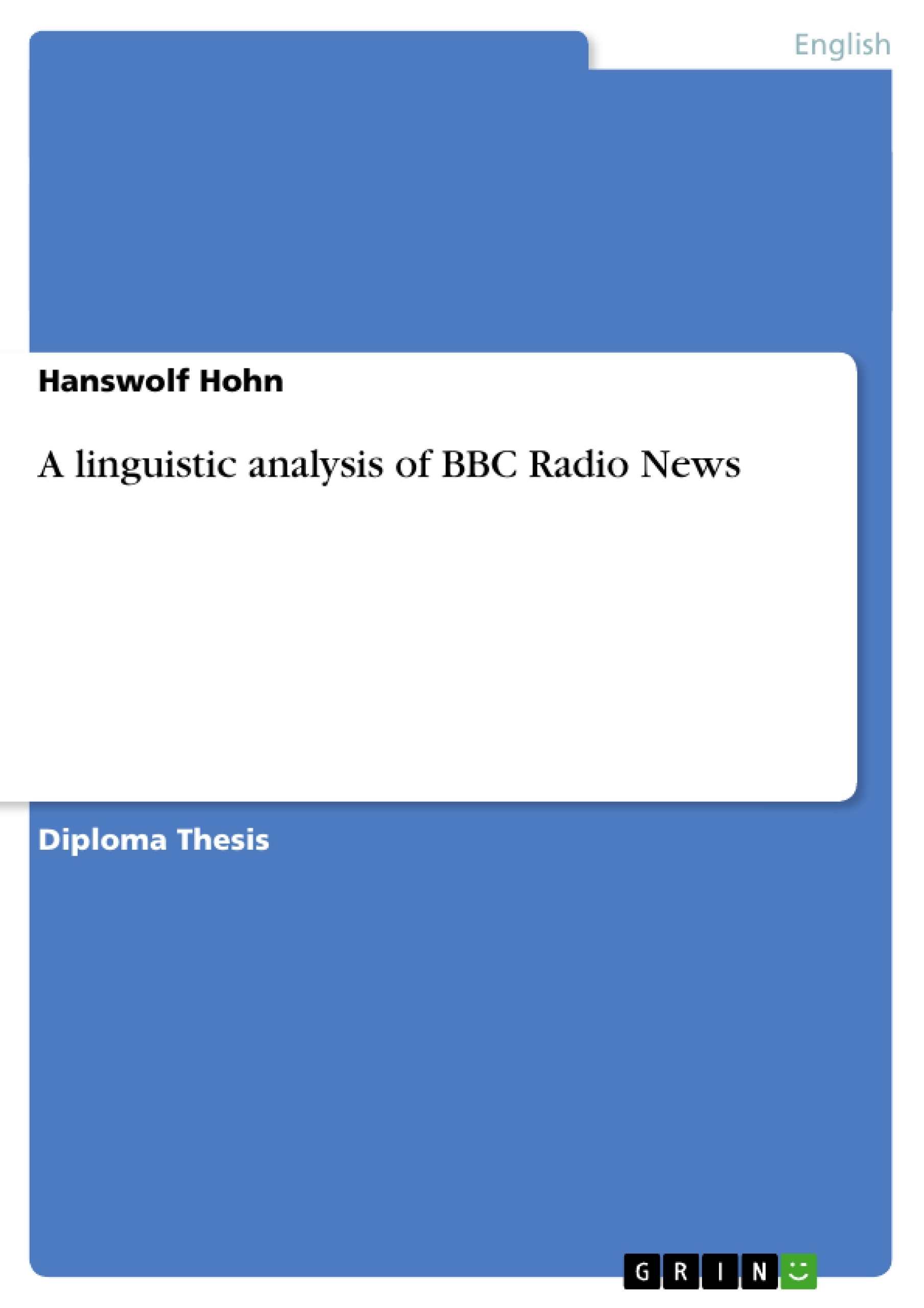Wie macht das die BBC mit der Sprache? Hier kann man es erfahren. Die auf Englisch verfasste Arbeit widmet sich der sehr spezifischen Formen der Radionachrichten bei BBC Radio One und BBC Radio Four - Sender, wie sie unterschiedlicher kaum klingen könnten. Diese Diplomarbeit belegt dieses "Bauchgefühl" mit interessanten linguistisch-stilistischen Analysen. Seine detaillierten, liebevollen Recherchen haben den Autoren sogar direkt in die heiligen Hallen des BBC Broadcasting House am Oxford Circus in London geführt. Die mit "sehr gut" benotete Arbeit ist nicht nur informativ, sondern auch unterhaltsam - und daher unbedingt lesenswert.
Inhaltsverzeichnis (Table of Contents)
- 1 INTRODUCTION.........
- 2 THEORETICAL BACKGROUND ......
- 2.1 Radio as a medium of news language
- 2.2 The importance of the news slot....
- 2.3 What is news?
- 2.3.1 News selection.
- 2.3.2 Hard news vs. soft news.
- 2.3.3 Home news vs. foreign news
- 3 INSIDE THE British broadcasting corporation........
- 3.1 The formation of BBC news....
- 3.1.1 Origins (1922-26)...
- 3.1.2 The pre-war period (1927-39).
- 3.1.3 The war-years (1939-1945).
- 3.1.4 The post-war period (1946-1960).
- 3.1.5 The recent past (1961-present)...
- 3.2 Taste and standards.
- 3.3 BBC English.............
- 3.1 The formation of BBC news....
- 4 The PROFILES of BBC radio STATIONS
- 4.1 BBC Radio 1
- 4.1.1 News on Radio 1..
- 4.2 BBC Radio 4
- 4.2.1 News on Radio 4.
- 4.1 BBC Radio 1
- 5 The language sample and its peculiarities..
- 6 MACRO-STRUCTURES OF BBC RADIO 1 AND 4 NEWS ........
- 6.1 The design of news bulletins on Radio 1 and 4.
- 6.2 News content.......
- 6.3 Updating in radio news.……........
- 6.4 The structure of radio news stories
- 6.4.1 The make-up of the lead...
- 6.4.2 The inverted-pyramid-principle......
- 6.4.3 Attribution to news sources in radio news..
- 6.4.4 Direct comparison of a comparable news item......
- 7 MICRO-STRUCTURES..
- 7.1 Sentence types
- 7.1.1 Altemative means to measure complexity..
- 7.2 Noun phrases ........
- 7.2.1 Premodification........
- 7.2.1.1 Premodification by adjectives
- 7.2.1.2 Premodification by nouns 61
- 7.2.1.3 Premodification by participles
- 7.2.1.4 Premodification by genitive
- 7.2.1.5 The distribution of premodification types
- 7.2.2 Postmodification ........
- 7.2.2.1 Postmodification by relative clauses 66
- 7.2.2.2 Postmodification by appositive clauses 67
- 7.2.2.3 Postmodification by nonfinite clauses
- 7.2.2.4 Postmodification by prepositional phrases
- 7.2.2.5 The distribution of types of postmodification
- 7.2.3 News actor labelling ........
- 7.2.4 Determiner Deletion.
- 7.2.5 Nominalisation….........
- 7.2.1 Premodification........
- 7.3 Verb phrases.........
- 7.3.1 Types of verbs
- 7.3.2 Tense...
- 7.3.3 Voice
- 7.3.4 Speech act verbs.
- 7.4 Contractions as an indicator of audience design...
- 7.1 Sentence types
- 8 CONCLUSION
- REFERENCES........
Zielsetzung und Themenschwerpunkte (Objectives and Key Themes)
This diploma thesis aims to provide a comprehensive linguistic analysis of BBC Radio news broadcasts, focusing specifically on BBC Radio 1 and 4. The study investigates the language used in these news broadcasts, examining both macro- and micro-structures to understand the specific linguistic features that contribute to their unique style and impact on listeners.
- The linguistic features of BBC Radio news broadcasts.
- The role of radio as a medium of news language.
- The importance of the news slot in radio broadcasting.
- The history and development of BBC news.
- The stylistic differences between BBC Radio 1 and 4 news broadcasts.
Zusammenfassung der Kapitel (Chapter Summaries)
- Chapter 1 introduces the topic of the study and provides background information on the importance of BBC radio news. It also outlines the research methodology and the specific data sources used in the analysis.
- Chapter 2 delves into the theoretical background of the research, discussing the role of radio as a medium of news language and the significance of the news slot. It also explores different aspects of "news" itself, including news selection, hard news vs. soft news, and home news vs. foreign news.
- Chapter 3 takes a closer look at the British Broadcasting Corporation (BBC), examining its history and development, its taste and standards, and its unique brand of "BBC English."
- Chapter 4 focuses on the profiles of BBC Radio 1 and 4, highlighting their respective strengths and weaknesses in terms of news broadcasting.
- Chapter 5 explores the specific language sample used in the study and its peculiarities, laying the groundwork for the analysis of both macro and micro structures.
- Chapter 6 investigates the macro-structures of BBC Radio 1 and 4 news broadcasts, examining the design of news bulletins, news content, updating strategies, and the structure of individual news stories.
- Chapter 7 dives into the micro-structures of the language used in these news broadcasts, analyzing sentence types, noun phrases, verb phrases, and other linguistic features.
Schlüsselwörter (Keywords)
This diploma thesis focuses on key concepts such as BBC Radio news, linguistic analysis, news language, macro-structures, micro-structures, sentence types, noun phrases, verb phrases, audience design, and the unique characteristics of BBC English.
- Quote paper
- Hanswolf Hohn (Author), 1995, A linguistic analysis of BBC Radio News, Munich, GRIN Verlag, https://www.grin.com/document/11227



